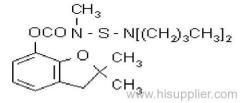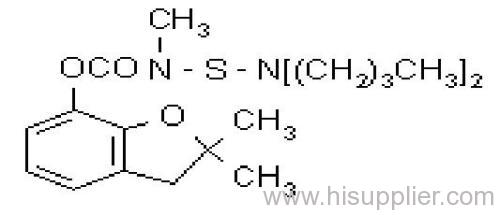Common name: carbosulfan
IUPAC name: 2,3-dihydro-2,2-dimethylbenzofuran-7-yl (dibutylaminothio)methylcarbamate
Chemical Abstracts name: 2,3-dihydro-2,2-dimethyl-7-benzofuranyl [(dibutylamino)thio]methylcarbamate
CAS RN: [55285-14-8]
EEC no.: 259-565-9
PHYSICAL CHEMISTRY
Mol. wt.: 380.5; M.f.: C20H32N2O3S; Form: Orange to brown clear, viscous liquid. B.p.: 124-128 ºC; V.p.: 0.041 mPa (25 ºC); Henry: 5.20x10-2 Pa m3 mol-1 (calc.) S.g./density: 1.056 (20 ºC). Solubility: In water 0.3 ppm (25 ºC). Miscible with most organic solvents, e.g. xylene, hexane, chloroform, dichloromethane, methanol, ethanol, acetone, etc. Stability: Hydrolysed in aqueous media; DT50 (25 ºC) in pure water <1 h (pH 4), 22 h (pH 6), 7.6 d (pH 7), 14.2 d (pH 8), >58.3 d (pH 9). F.p.: 95 ºC (closed cup)
APPLICATIONS
Biochemistry: Cholinesterase inhibitor; activity is due to in vivo cleavage of the N-S bond, resulting in conversion to carbofuran.
Mode of action: Systemic insecticide with contact and stomach action.
Uses: Control of a wide range of soil-dwelling and foliar insect pests. Examples of uses include control of millipedes, springtails, symphylids, wireworms, pygmy mangold beetles, frit flies, white grubs, aphids, caterpillars, flea beetles, Colorado beetles, stem borers, leafhoppers, planthoppers, codling moth, scales and free-living nematodes. The product is used in a wide range of crops, e.g. cotton, sugar beet, potatoes, rice, top fruit, citrus, maize, vegetables, sugar cane and coffee.
Formulation types: CS; DP; EC; GR; UL; WP.
Compatibility: Compatible with liquid fertilisers.
MAMMALIAN TOXICOLOGY
Oral: Acute oral LD50 for male rats 250, female rats 185 mg/kg.
Skin and eye: Acute percutaneous LD50 for rats >2000 mg/kg. Slight eye irritant; moderate skin irritant.
Inhalation: LC50 (1 h) for male rats 1.53, female rats 0.61 mg/l air.
NOEL: (2 y) (oncogenic) for rats and mice 20 mg/kg diet.
ADI: 0.01 mg/kg b.w.
Toxicity class: WHO (a.i.) II; EPA (formulation) I (4 EC), II (2.5 EC)
EC hazard: T; R23/24| R43| N; R50, R53
ECOTOXICOLOGY
Birds: Acute oral LD50 for mallard ducks 8.1, quail 82, pheasants 20 mg/kg.
Fish: LC50 (96 h) for bluegill sunfish 0.015, trout 0.045 mg/l.
Daphnia: LC50 (48 h) 1.5 g/l.
Algae: (96 h) 20 mg/l.
Bees: Toxic to bees.
ENVIRONMENTAL FATE
Animals: In rats, following oral administration, rapidly metabolised by hydrolysis, oxidation and conjugation, forming carbofuran methylol, carbofuran phenol, and their 3-hydroxy and 3-keto derivatives; the metabolites are rapidly excreted.
Plants: Metabolites include carbofuran (q.v.) and 3-hydroxycarbofuran.
Soil/Environment: In soil, rapidly degraded under both aerobic and anaerobic conditions; DT50 c. 2-5 d; DT90 <3-38 d; the principal metabolite is carbofuran (q.v.). Under field conditions, carbosulfan and carbofuran are unlikely to leach to groundwater.









